Mike Naylor began farming on his own in 1979 after taking over his father’s farm. Within five years, he converted to organic practices, before there were many organic certification programs or much published research to guide him.
He was 26 at the time, farming a total of about 50 acres—13 acres in peaches and the rest in raisins and table grapes.
“My father had made good money the last five years before I took over, so the financial outlook appeared good,” he told Good Fruit Grower during late spring. “The mid- to late 1970s were killer years for stone fruit, but that didn’t last long and ended after my first three years.”
In 1984, he began converting to organic as a way to find a niche market and improve his prices at the farm. From the start, he had field packed and sold his own fruit through a commission merchant, instead of dropping it off at a commercial packer. As he considered going organic, he had support from one of his main customers, an upscale market in the Bay Area. Another customer in Colorado was also supportive of his organic move.
“Back then, organic was about trust and a handshake,” said Naylor. “Organic certificates or certification programs were not necessary then.”
These days, Naylor Farm Organics operates about 95 acres in two locations. Some 25 acres are currently fallow and would have been planted if not for California’s severe drought. And despite the drought, his stone fruit trees produced a good crop.
This year’s season came about two weeks early. The season usually runs mid-May through mid-August, but he started picking this year on May 1. He keeps a crew of about 20 busy, starting with thinning in mid-March or early April and then moving on to picking. He pays by the hour because he found quality of work improved compared to piece rate. Most of the same workers return each year and stay through the season.
Varieties are chosen by their flavor and consumer appeal. Because peaches are more popular than nectarines, he has about 50 acres of peaches and less than half that in nectarines. He grows new and heirloom-type varieties, such as the newer peach varieties of Sierra Rich and Pearl White, but also the older Babcock and Nectar peaches.
To market his fruit, Naylor uses Sutherland Produce Sales, Inc., which specializes in organics. His customer base stretches across the nation and includes large organic stores like Whole Foods and small specialty stores, restaurants, and foodservice. He also markets his fruit in about ten farmers’ markets, mostly in southern California.
Organic challenges
Once the decision to go organic was made, Naylor then had to figure out the how.
“In the early 1980s, there wasn’t much information about organic farming for stone fruit. None of the extension agents could provide information,” he said. “Years later, the industry realized we were of value, but not initially.”
Scale was his first big insect problem, and he had no idea how to control it. “I remember as a kid that my dad missed a scale spray and he lost scaffolds because of it,” he said. He first used oil sprays. Eventually, natural predators built up and helped control the insect. “I got smarter as I went.”
Thrips, peach twig borer, spider mites, aphids, brown rot, and mildew have also tested his organic know-how. He’s tried a lot of different things—released beneficial insects, sprayed water at sunset to control spider mites, and used organically approved pesticides. Pest control has gotten easier because there are more effective organic pesticides available than in the past. But even now, for some pests like peach twig borer, he’s found it more economical to not grow late-season peaches and nectarines than try to control high pest populations. He no longer grows organic plums for wholesale because market prices weren’t high enough for the quality of fruit he was producing.
Spotted wing drosophila has not yet impacted his organic farming, though he is watching closely. He has a few rows of blackberries for U-pick, a prime target for the tiny fruit fly that may serve as a sentinel.
Weeds are his biggest challenge. He uses furrow irrigation, which can be 80 to 90 percent efficient if furrows can be kept free of weeds so water can flow freely. With furrow irrigation, he is able to control weeds by mowing under trees with a Perfect Mower. He keeps furrows weedfree with a Bezzerides rotary hoe.
“If I switch to drip irrigation and use fan jets, I would then need weed eaters and hand labor,” Naylor said, adding that subsurface or buried drip irrigation probably wouldn’t work with his gophers.
He’s tried flaming for weed control, but with California’s current drought, fire is an issue. “I usually can’t flame past early May or I’ll start a fire,” he said, adding that for the first time ever, he accidentally started a fire in January this year. He’s also purchased a steamer to use superheated steam to control weeds. The steamer, which cost about $20,000, works well on young weeds but a drawback is that it only does one side at a time.
“I’ve spent a fortune on different weed control devices,” he said. “I’m trying to be as no-till as I can, but it’s a balance. How organic are you if you’re always on the tractor cultivating?”

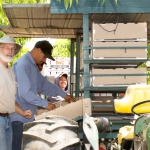
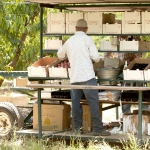
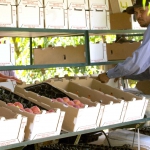
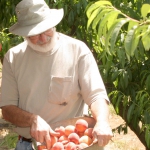
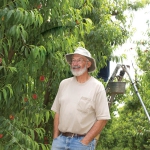





Great story and thanks for all your organic hard work Mike. Keep up the good work!
Regards,
Freshana Organic Solutions.
Hi
I’m Bill Sutherland of Sutherland Produce Sales, Inc.
Loved your story on Mike Naylor. He’s a great grower and a marvelous man.
We are honored to represent his fruit.
We would love it if you would do a story on my company. I’ve been in the Organic
Trade for almost 40 years. Sutherland Produces has been around for close to 30 years.
I have a lot of great stories to tell about the growth, changes and fun in our industry.
We are working on a new Website and will be finished soon.
Thank you,
Bill Sutherland
619 588 9911